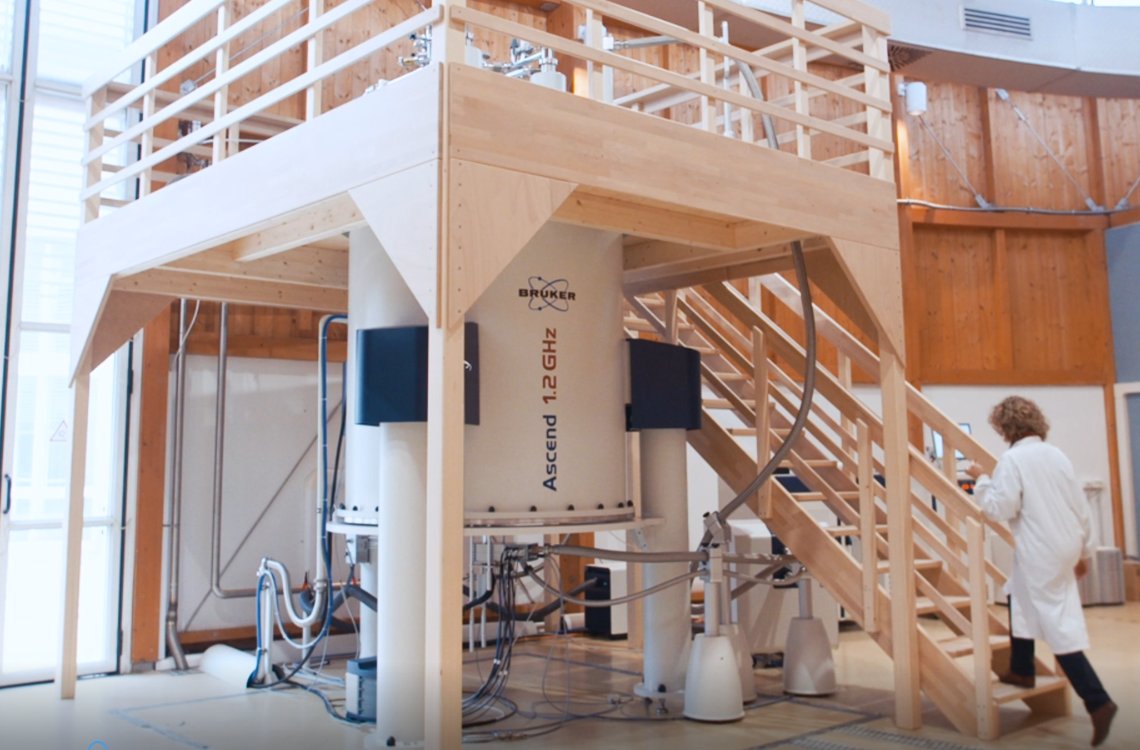CERM/CIRMMP provides state of the art instrumentation and expertise to perform the most comprehensive array of experiments needed for the structure and dynamic characterisation of biological macromolecules and their complexes. All the standard pulse sequences for spectroscopic, structural and dynamical characterisation are available for attaining fundamental atomic level information such as chemical shift assignment, 15N relaxation measurements, structure elucidation and protein-ligand interactions. CERM/CIRMMP has developed 13C direct detection protocols for “protonless” NMR experiments and for in-cell NMR spectroscopy, and tailored pulse sequences for structural determination of paramagnetic systems as well as for the study of Intrinsically Disordered Proteins and Regions (IDPs and IDRs).
The infrastructure is equipped with high and ultra-high field spectrometers equipped with cryoprobes (1.2 GHz 5mm TXO and 3mm TCI cryo, 950 MHz TCI cryo, 900 MHz TCI cryo, 700 MHz TCI cryo, 700 MHz TXO cryo, 600 MHz (19F-QCI cryo) 500 MHz 31P-QCI cryo), heteronuclear detection probes at 600 MHz for low frequency nuclei to meet the most disparate experimental needs, liquid handler system and autosamplers for metabolomics and ligand screening at 400, 600 and 700 MHz. Special accessories include high power probes (short hard pulse) at 400 and 600 MHz for paramagnetic NMR, and the gradient amplifier and BBO probe at 700MHz for DOSY measurements. Most of the NMR instruments are equipped with the Bruker Avance NEO consoles enabling the application of multiple receiver NMR experiments.
Expertise described below is not exhaustive and experiments can be adapted, and expanded on the basis of the user needs.
Structural and dynamic behaviour determination
Excellent instrumentation and expertise are available to users for acquiring all the conventional experiments required for protein structure determination. A range of 15N relaxation rate measurements can further complement the structural information.
Structural and dynamic characterisation of metalloproteins and paramagnetic systems
In proteins, the relaxation properties of various 13C nuclei can be exploited to obtain structural information and combined with other conventional NMR observables to enhance both the quality and quantity of the data. Paramagnetic complexes can also be investigated by integrating high-resolution NMR with fast-field-cycling relaxometry.
13C-direct detected experiments
The specific available setup of two cryoprobes for 13C detection at 1.2 GHz and 700 MHz allow for the exploitation of these experiments on a variety of systems, including IDPs or multidomain proteins. The available pulse sequences include a variety of 2D and nD (n≥3) experiments, also acquired exploiting advanced strategies including Non Uniform Sampling or multiple receivers.
In-cell NMR experiments for insights into the structure, dynamics, and function of macromolecules within living cells
Novel methods have been developed to investigate interactions between proteins and small molecules, providing atomic-resolved, physiologically relevant data otherwise difficult to obtain. Among the available applications, 19F in-cell NMR can be employed to monitor drug permeability and target binding. Innovative approaches have also been established to perform backbone or side chain amino-acid-selective labelling of proteins expressed in human cells. A flow NMR bioreactor allows time-resolved in-cell NMR studies by preserving cell viability for up to 72 hours. Applications include protein structural analysis, drug-target interaction and studies of cell metabolism.
NMR strategy to investigate Protein-Ligand interaction
A wide range of NMR strategies to study protein–ligand interactions are available to perform high-throughput screening of fragments, which are crucial for drug development. High- and ultra-high-field NMR allow protein-based characterization even at low protein concentrations. This can be complemented by 1H-, 19F- and 31P-detected experiments to monitor interactions from the ligand perspective.
High Order Structure (HOS) determination (description available soon)
Diffusion Order Spectroscopy (DOSY)
The DOSY technique determines molecular diffusion coefficients, providing insights into size, interactions, and molecular organization in solution. It is valuable for distinguishing components in complex mixtures through high-resolution and multidimensional DOSY-NMR experiments. Our instrumentation includes several spectrometers; notably, the 700 MHz wide-bore system features high-performance gradients for a broad diffusion range and a BBO probe for heterogeneous samples.
To get structural information on proteins by solution NMR, 15N and/or 15N/13C isotopically labelled samples are usually required. For very large folded proteins, deuteration might also be needed.
Crucial for optimal NMR sample are protein concentration and buffer composition. Depending on the structural and dynamic features of the sample and on the scientific question of the applicant, optimal protein concentration is usually in the range of hundreds of micromolar or higher.
Buffers with low salt concentration, when possible, are often preferred over high-salt-concentration buffers.
The applicant is always welcome to directly contact the scientific staff of CERM/CIRMMP prior access proposal submission for the evaluation of the feasibility of the project.
The support, when requested, includes sample handling, setup of NMR experiments, data acquisition, data analysis and data sharing. Based on the expertise of the visiting scientist, assistance and supervision will be assigned.
For remote access, if the samples are not shipped in the NMR tube, our staff takes care to transfer them to the NMR tube (3mm, 5mm, shigemi, shaped tubes are available); air-sensitive samples will be handled in an oxygen-free chamber. Our staff will operate in concert with the applicant following the protocol for operations (air/light sensitivity, temperature of storage, etc…) provided together with the samples.
The visiting scientist must communicate the scientific plan of the experiments and the contacts to arrange the visit. On average, a visit is one week of instrument time and it can be arranged as a physical visit to the facility or by mailing-in the samples.
Contact the facility staff before submitting your proposal, so that the access request is in agreement with the scientific plan of the experiments.


